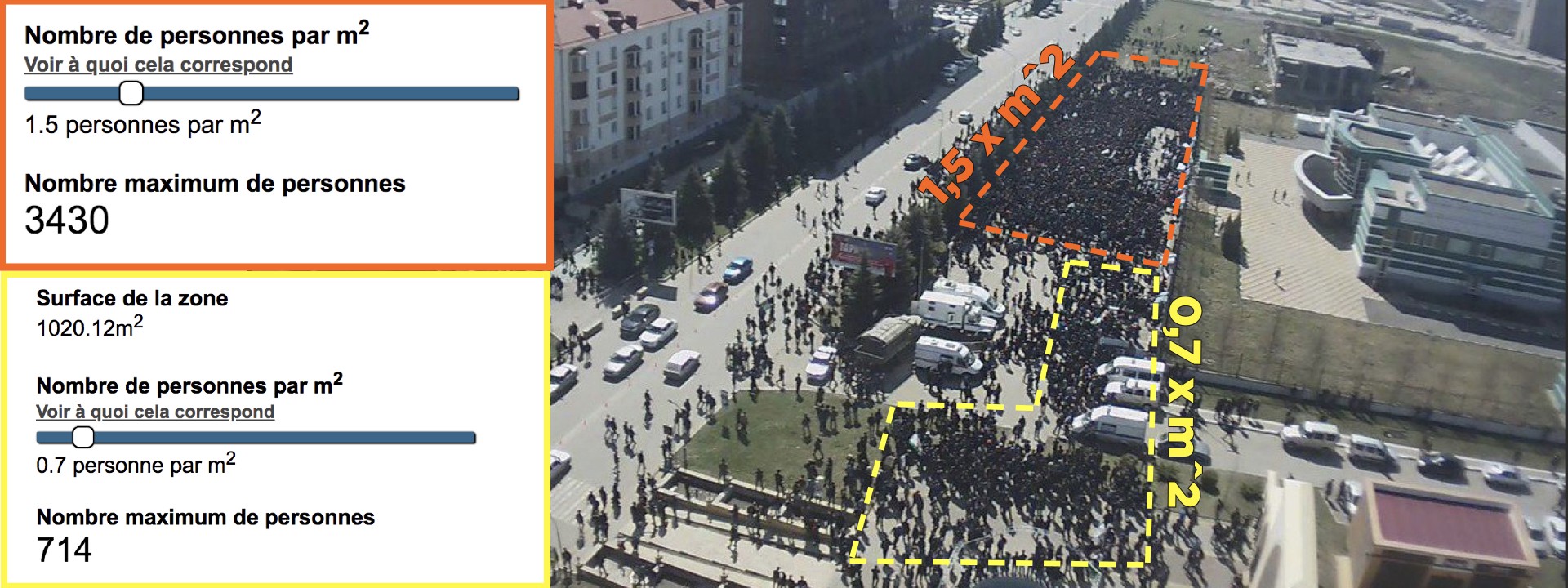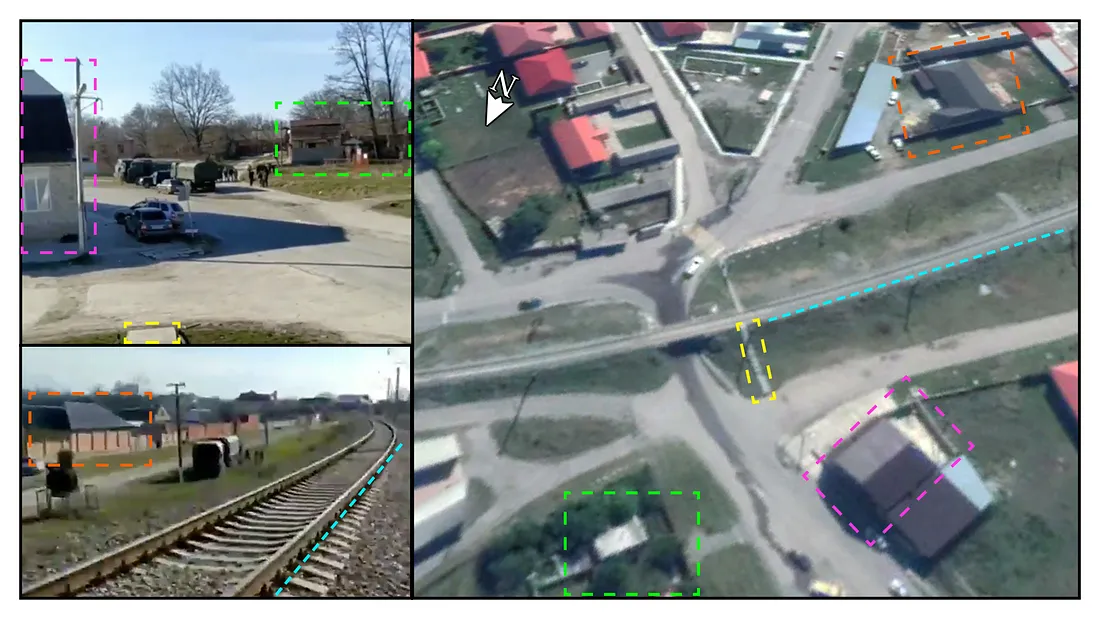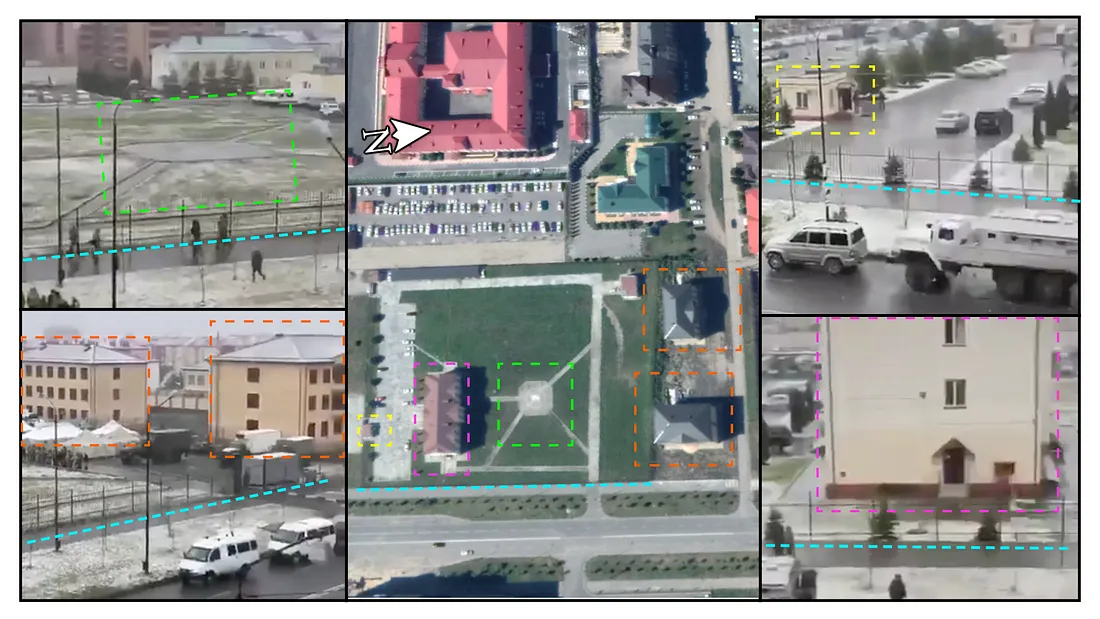Protests in Ingushetia Met with Police Batons
Renewed Ingushetian protests were met by a police force allegedly from Russia
Protests in Ingushetia Met with Police Batons

BANNER: (Source: @Landriukaitis/DFRLab via Mapchecking.com, top left; Mapchecking.com, bottom left; Liveuamap, right)
Protests in Ingushetia erupted again after controversy arose around a law regarding popular referenda when the government considers land transfers. The protests were later allegedly dispersed by Russian National Guard troops.
Chechnya and Ingushetia signed a land deal in the fall of 2018, which sparked outrage among the Ingush public. The deal gave the Chechen Republic over 7 percent of Ingushetia’s land and brought thousands of Ingushetians to the streets of their capital, Magas, to protest peacefully. The DFRLab monitored those protests, which ultimately fell apart in November 2018.
In response to the earlier demonstrations around the land transfer, the Ingush legislature in late March struck a paragraph from a law under deliberation that mandated referenda on issues related to changes to the Republic’s territory. The change made it so that the Ingush government could sign further territorial deals with Chechnya without public input, leading thousands of people to once again flood the streets on March 26 to demand the resignation of the head of the Ingush Republic, Yunus-bek Yevkurov. Unlike in previous demonstrations, this time the Kremlin allegedly sent Russian police forces from outside of Ingushetia to disperse the protesters by force.
The organizers had petitioned the government to hold the protest over three days, and the government only approved the demonstration for one day. That day, the protests took place in the approved designated area, as well as on the outskirts of Nazran, the largest city in Ingushetia. The police dispersed the crowd on the morning of the second day.
The presence of Russian police from outside the Ingush territory demonstrates the Kremlin’s continued commitment to keeping the populace in Russia’s more rural republics under control, especially when done in the service of strengthening one of its puppet territorial leaders, Ramzan Kadyrov of Chechnya.
Earlier Waves of Protests in Ingushetia
The first wave of protests erupted in the Ingush capital of Magas soon after the leaders of the Chechen Republic and Republic of Ingushetia signed a border agreement in late September 2018.

The protests began in earnest on October 4, the same day Russian OMON (federal special purpose police forces) arrived into the city, establishing a perimeter around the protesters. On October 5, some local police officers joined the protesters, who were followed by Ingushetia’s first president, Ruslan Aushev, on October 7.
On October 17, the “official permit” for the demonstrations lapsed, and the protests ceased. The organizers vowed to resume their demonstrations for three days starting on October 31, pending the renewal of their government-issued permit. Additional OMON troops were recorded driving into Ingushetia on October 19, and the situation stabilized soon after, as the protesting crowds dispersed. Open-source data related to the protests is scarce after this period.
The new wave of protests erupted in March 2019, as the Ingushetians came out to the streets protest the revised referendum law. On March 14, Ingushetia’s People’s Assembly passed the first reading of the updated law, a version that did not include the paragraph mandating referenda ahead of land transfers. This change was later claimed to have been an error by the Assembly’s Vice Speaker and prompted thousands of protesters to demand both the inclusion of the mandatory referendum paragraph and the resignation of Yevkurov.
Size of the March 2019 Crowd
On March 27, 2019, The Moscow Times reported that more than 10,000 protesters had rallied in Magas to express their dissatisfaction with the law. A few photos of the protest on March 26 appeared on social media and days later on news media outlets, showing the protesting crowd next to the NTRK “Ingushetiya” building in Magas. Reverse image search confirmed that these photos were not taken during the Fall 2018 protests.
These photos allowed the DFRLab to estimate the approximate number of protesters in the crowd.
Two main clusters of protesters were observed and their numbers were calculated by using an open-source tool from Mapchecking.com. The cluster marked in orange were at least twice as dense as the one marked in yellow. According to the data from Mapchecking, there were around 3,400 protesters (using an estimate of 1.5 people per square meter) in the orange area and around 700 (using an estimate of 0.7 people per square meter) in the yellow, totalling around 4,100 protesters.

The extent to which the crowd size varied throughout the day is unclear, as more aerial view photos were not found. Yet, according to the available open-source data, the estimated count of 10,000 protesters provided by various media outlets is likely inflated.
Another group of protesters appeared in pictures that surfaced on social media on March 27. This group was allegedly organizing a blockade on the federal Caucasus highway, but the location of the blockade was not disclosed on the surfaced tweet. The analysis of the three surfaced photos allowed for geolocation of the blockade. The Magas Lil gas station seen in the lower-right image served as the main lead to finding the locations. Furthermore, the sign marked in the dashed yellow line was cross-referenced with the top right image of the city of Nazran sign. The blockade was located to be in the eastern part of Nazran, where the Caucasus highway meets the entrance to the city.

It is not known how many protesters participated, as only parts of the crowd were visible in the pictures. At least a few hundred locals were visible in the available data, however. The blockade on the main transportation area of the country lasted only for a few hours, according to some reports, until the protest organizers persuaded the demonstrators to disperse.
Police Intervention
Unlike the fall protests, the local government approved the March protests but only for one of the three requested days. As most of the crowd dispersed after the full day of protests, only a couple of hundred remained throughout the night. In the early morning, these remaining protesters were met by the police forces in full riot gear.
Several videos of security forces, reported to be Russian National Guard troops, clashing with the protesters were available on YouTube and other social-media outlets.
The geolocation of the video confirmed that the information was correct, as the clashing took place at exactly the same place as the protests the evening before.
Reportedly, the protesters managed to repel the initial two advances of the storming policemen by hurling nearby objects, including chairs, at them. The local Ingushetian police forces reportedly did not participate in the arrests or the dispersion of the crowds.
Reports of Russian Troops in the Region
As the March 26 protests dispersed, additional troops, reportedly sent by Moscow, arrived in Ingushetia to suppress additional demonstrations. The exact location from which these forces were sent and the exact units to which they belonged are currently unknown, but, on March 31, 2019, the first photos and videos of these units started surfacing around the country.
The trucks and dark uniforms seen in the imagery resembled those of the troops sent to control the Fall 2018 protests. These earlier troops had appeared to be Russian OMON.
The DFRLab geolocated the images.
The photo was geolocated to be north of Nazran. The blurred logo in the background appeared to be a sign of the Narus gas station. Google Maps suggested that only one Narus gas station was present in the region. Comparison of the photos and satellite imagery confirmed the location.

Another smaller contingent of troops was geolocated in Nazran itself, adjacent to a railway that crossed the eastern side of the city.

Yet another column of alleged Russian troops was recorded in a populated area, next to a large fenced area with tents. The tents suggested that this was the location where the troops set up their temporary base of operations.
В Назрань и Магас прибывают новые подразделения карателей. https://t.co/UqUClxPOXT pic.twitter.com/vUbbcxJ3NJ
— Грани.Ру (@GraniTweet) March 29, 2019
This area was geolocated to be in the capital of Ingushetia, Magas. The exact location was likely only a few blocks from the location of the protests.

On the same day, photos of raids started appearing on social media, allegedly carried out by the same troops. The official justification for these raids was to confiscate weapons from individuals with nonexistent or expired gun ownership licenses.
This operation caused large queues outside the Internal Affairs building, as gun owners rushed to extend their ownership licenses.
Conclusion
By March 27, the new wave of protests had ceased and the remaining barricades had been taken down. As protesters left the streets and joined the protest leaders in mosques, the struggle against the land deal was once again primarily the concern of the republic’s political elite.
According to photos and videos that surfaced on social media on March 31, Russia likely sent large forces of what appeared to be OMON troops to Ingushetia to maintain order. There is no additional open-source data to suggest that the troops continued to intervene or employ force in other incidents following the March 26 protests.
The situation in the republic remains tense, yet the border deal is not likely to be reversed. As for now, the changes in the referenda law also remain intact, and Yevkurov has not indicated that he intends to resign. In light of the Ingush public’s apparent acceptance, albeit reluctant, of the situation and the large numbers of security forces sent into the republic to maintain order, the situation will likely remain stable.
The DFRLab will continue to monitor the political and security situation in Ingushetia.
Register for the DFRLab’s upcoming 360/OS summit, to be held in London on June 20–21. Join us for two days of interactive sessions and join a growing network of #DigitalSherlocks fighting for facts worldwide!

